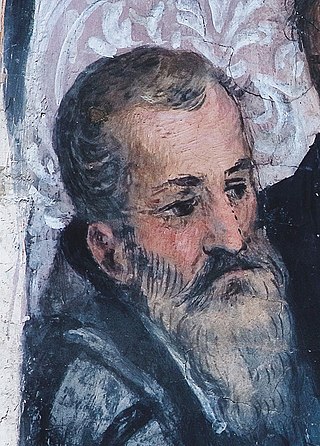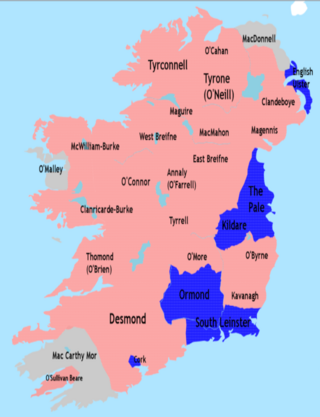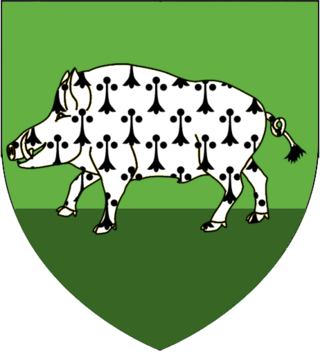
Hugh O'Neill, was an Irish Gaelic lord, Earl of Tyrone and was later created The Ó Néill Mór, Chief of the Name. O'Neill's career was played out against the background of the Tudor conquest of Ireland, and he is best known for leading a coalition of Irish clans during the Nine Years' War, the strongest threat to the House of Tudor in Ireland since the uprising of Silken Thomas against King Henry VIII.

Shane O'Neill, was an Irish chieftain of the O'Neill dynasty of Ulster in the mid-16th century. Shane O'Neill's career was marked by his ambition to be the O'Neill—sovereign of the dominant O'Neill family of Tír Eoghain. This brought him into conflict with competing branches of the O'Neill family and with the English government in Ireland, who recognised a rival claim. Shane's support was considered worth gaining by the English even during the lifetime of his father Conn O'Neill, 1st Earl of Tyrone. But rejecting overtures from Thomas Radclyffe, 3rd Earl of Sussex, the lord deputy from 1556, Shane refused to help the English against the Scottish settlers on the coast of Antrim, allying himself for a short time instead with the MacDonnells, the most powerful of these settlers, Shane viewed the Scottish settlers as invaders, but decided to stay his hand against them with hopes of using them to strengthen his position with the English; however, tensions quickly boiled over and he declared war on the Scottish MacDonnell's defeating them at the Battle of Glentaisie despite the MacDonnells calling for reinforcements from Scotland. The Scottish MacDonnells would later assassinate Shane O'Neill and collect the bounty on his head.

The Nine Years' War, sometimes called Tyrone's Rebellion, took place in Ireland from 1593 to 1603. It was fought between an Irish alliance—led mainly by Hugh O'Neill of Tyrone and Hugh Roe O'Donnell of Tyrconnell—against English rule in Ireland, and was a response to the ongoing Tudor conquest of Ireland. The war was fought in all parts of the country, but mainly in the northern province of Ulster. The Irish alliance won some important early victories, such as the Battle of Clontibret (1595) and the Battle of the Yellow Ford (1598), but the English won a victory against the alliance and their Spanish allies in the siege of Kinsale (1601–02). The war ended with the Treaty of Mellifont (1603). Many of the defeated northern lords left Ireland to seek support for a new uprising in the Flight of the Earls (1607), never to return. This marked the end of Gaelic Ireland and led to the Plantation of Ulster.

The Battle of the Yellow Ford was fought in County Armagh on 14 August 1598, during the Nine Years' War in Ireland. An English army of about 4,000, led by Henry Bagenal, was sent from the Pale to relieve the besieged Blackwater Fort. Marching from Armagh to the Blackwater, the column was routed by a Gaelic Irish army under Hugh O'Neill of Tyrone. O'Neill's forces divided the English column and a large earthwork stalled its advance. Bagenal was killed by an Irish musketeer, and scores of his men were killed and wounded when the English gunpowder wagon exploded. About 1,500 of the English army were killed and 300 deserted. After the battle, the Blackwater Fort surrendered to O'Neill. The battle marked an escalation in the war, as the English Crown greatly bolstered its military forces in Ireland, and many Irish lords who had been neutral joined O'Neill's alliance.

The Battle of Clontibret was fought in County Monaghan in May 1595, during the Nine Years' War in Ireland. A column of 1,750 English troops led by Henry Bagenal was ambushed near Clontibret by a larger Gaelic Irish army led by Hugh O'Neill, Earl of Tyrone. The English column had been sent to relieve the besieged English garrison at Monaghan Castle. The English suffered very heavy losses, but a suicidal cavalry charge apparently saved it from destruction. The Irish victory shocked the English and was their first severe setback during the war.

The Ó h-Anluain family was an agnatic extended family comprising one of a string of dynasts along the Ulster-Leinster border. Depending on the advantage to the clan, the Chief of the Name—The O'Hanlon—supported either the Earl of Tyrone or authorities within the English Pale. During the 15th century, ties were close with the famed Earls of Kildare. Frequently, members of the clan would fight on both sides during a rebellion. Some would be outlawed; others pardoned; some ending up on the winning side.

Sir Richard Bingham was an English soldier and naval commander. He served under Queen Elizabeth I during the Tudor conquest of Ireland and was appointed governor of Connacht.
Hugh McShane O'Neill was an early modern Irish nobleman and rebel associated with the McShanes of Glenconkeyne and Killetra. This group was also called the "Wild Clan Shanes of Killetragh" or the "McShane-O'Neills". His parentage is disputed however he is claimed by some as being either a grandson or great-grandson of Conn O'Neill, 1st Earl of Tyrone, and Gearoid Mór Fitzgerald, 8th Earl of Kildare, and of the primary line of the O'Neill of Tyrone clan.
Sir Henry Bagenal PC was marshal of the Royal Irish Army during the reign of Queen Elizabeth I.

MacShane is a patronymic surname originating in Ireland. The surname evolved from the given name Shane, a derivative of John, of Hebrew origin. Early records spelled the name Mac Seáin or Mac Seagháin. Historically, the MacShanes from Ulster are a branch of the O'Neills, while in County Kerry, the surname was adopted by the Fitzmaurices. MacShane is uncommon as a given name.
McCaul, also spelt MacCawell is an Irish surname, derived from the Gaelic Mac Cathmhaoil, meaning the "son of Cathmhaol", descendant of being implied. The name Cathmhaoil itself is derived from cath mhaol meaning "battle chief". The Mac Cathmhaoil were the leading family of Cenél Fearadhaigh, of the Uí Néill, and were based around Clogher in modern-day County Tyrone, Northern Ireland. They were one of the seven powerful septs that supported the O'Neills. Mac Cathmhaoil is now rare in Ulster as it has been Anglicised under various different forms such as, Campbell, McCawl, Caulfield, McCall, Alwell, Callwell, McCowell, McCuill, Howell, MacHall, and McQuade.
Con(n) MacShane O'Neill (1565–1630) was an Irish flaith or Prince of Ulster, the Lord of Clabbye, nobleman, rebel, and political leader in the late 16th century and early 17th century.

Edmund MacGauran was the Roman Catholic Archbishop of Armagh, Ireland from 1587 to 1593 and Bishop of Ardagh from 1581 to 1587.
Events from the year 1593 in Ireland.
Events from the year 1591 in Ireland.

The siege of Enniskillen took place at Enniskillen in Fermanagh, Ireland, in 1594 and 1595, during the Nine Years' War. In February 1594, the English had captured Enniskillen Castle from the Irish after a waterborne assault and massacred the defenders after they surrendered. From May 1594, an Irish army under Hugh Maguire and Cormac MacBaron O'Neill besieged the English garrison in the castle, and in August they defeated an English relief force. A second relief force was allowed to resupply the garrison, but the castle remained cut off. Eventually, in May 1595, the English garrison surrendered to the Irish and were then massacred.

The Battle of the Ford of the Biscuits took place in Fermanagh, Ireland on 7 August 1594, during the Nine Years' War. A column of almost 650 English troops led by Sir Henry Duke was ambushed and defeated by a Gaelic Irish force under Hugh Maguire and Cormac MacBaron O'Neill at the Arney River. The English column had been sent to relieve and resupply Enniskillen Castle, which had been under siege by the Irish since May. The English suffered at least 56 killed and 69 wounded, and were forced to make a hasty retreat.
Tomás Óg Mág Samhradháin was chief of the McGovern Clan and Baron or Lord of Tullyhaw barony, County Cavan from 1584 until his death at the end of the 16th century.
The Battle of Belleek, also known as the Battle of the Erne Fords, was fought on the River Erne near Belleek in Fermanagh, Ireland, on 10 October 1593. It was part of the buildup to the Nine Years' War. The battle was fought between a Gaelic Irish army under Hugh Maguire, lord of Fermanagh—who had begun a revolt against the English—and an English Crown expeditionary force under Sir Henry Bagenal, supported by Hugh O'Neill, Earl of Tyrone. Maguire's force was defeated, but the bulk of his army was unscathed. Hugh O'Neill would later join Maguire in war against the English.










